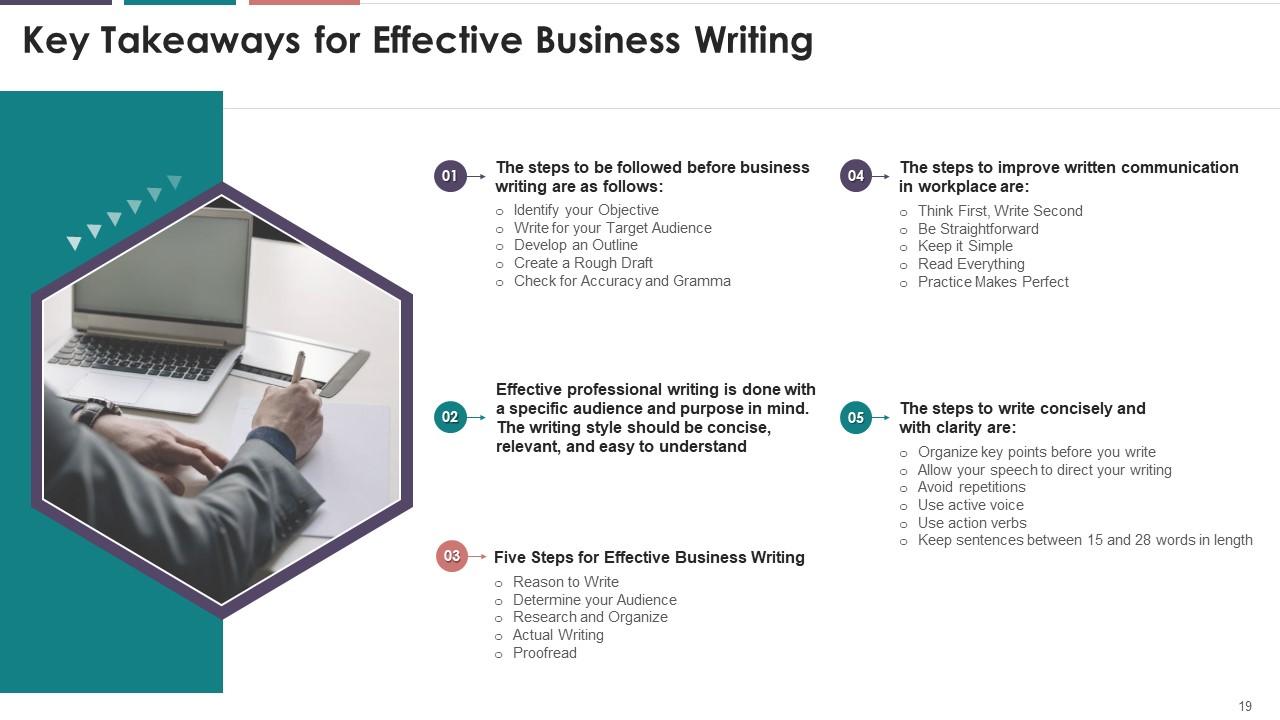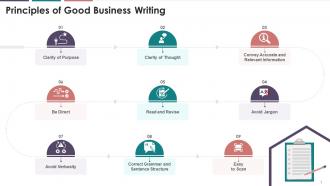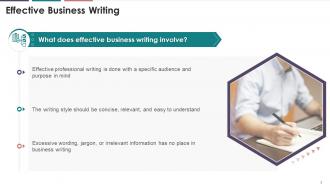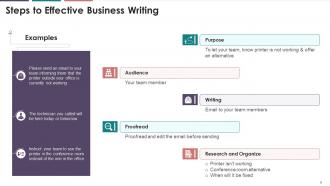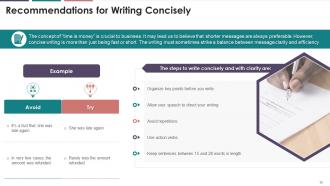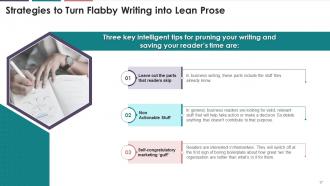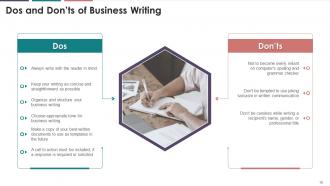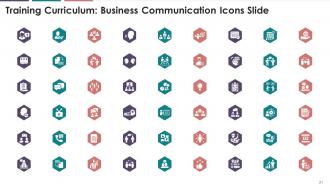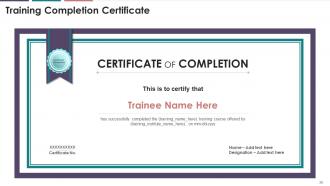Prewriting Strategies For Effective Business Writing Training Ppt
This set of slides highlights the prewriting approach for effective written business communication. It includes steps to write influentially, such as identifying the reason to write, determining the target audience, researching and organizing, writing, and proofreading. Further, it covers the HABITS heading, artwork, bold, italics and typeface, and space framework for designing effective messages. It also includes recommendations for writing concisely and turning flabby writing into lean prose.
You must be logged in to download this presentation.
PowerPoint presentation slides
Presenting Prewriting Strategies for Effective Business Writing. This slide is well crafted and designed by our PowerPoint specialists. This PPT presentation is thoroughly researched by the experts, and every slide consists of appropriate content. You can add or delete the content as per your need.
People who downloaded this PowerPoint presentation also viewed the following :
Content of this Powerpoint Presentation
Slide 1
This slide depicts the principles of good business writing in business communication. The principles are clarity of purpose, clarity of thought, avoiding jargon, reading and revising avoid verbosity, correct grammar and sentence structure, etc.
Instructor’s Notes:
The Principles of Effective Business Writing
- Clarity of Purpose - Before beginning a business document, memo, or email, two primary questions should be considered:
- Who exactly is the reader?
- What message do I want to send to the reader through my writing?
- Clarity of purpose directs the writing and shapes its tone, structure, and flow
- Clarity of Thought - Business writing necessitates the ability to summarize long, scattered sentences into concise, clear ones. To write clearly, one must extract what is essential
- Convey Accurate and Relevant Information - The purpose of business writing is to deliver critical information. The objective of the document gets jeopardized by inaccurate or irrelevant content
- Avoid Jargon - A straightforward and uncluttered writing style goes a long way toward conveying the message to the reader. Writing with industry-specific buzzwords and acronyms should be avoided to the extent possible. Otherwise, the reader may be unable to understand or lose interest in the document
- Read and Revise - Reading the document aloud after it has been completed can reveal flaws and gaps. Constructive feedback from colleagues should be welcome
- Be Direct - When it comes to business writing, presenting the passage's main point in the first 150 words is a good idea as it saves the reader's time
- Avoid Verbosity - If the meaning can be expressed in three words, never use five. Verbosity hinders the reader's ability to engage with the writing
- Correct Grammar and Sentence Structure - A grammatical error appears unprofessional, good grammar demonstrates attention to detail and skill, which are highly valued in business
- Easy to Scan - Business executives value a document that can communicate its message through an executive summary. Business documents can be improved by using numbered or bulleted lists, clear headings, concise paragraphs, and thoughtfully-used bold formatting to highlight keywords
Slide 2
This slide illustrates the steps to be followed before business writing. The steps are to identify your objective, write for your target audience, develop an outline, create a rough draft, and check accuracy and grammar.
Instructor’s Notes:
The steps to be followed before business writing are as follows:
- Identify your Objective - Business writing typically serves one of the four objectives: to convey information, provide instructions, persuade, or define a transaction. Take time to clearly define why you are writing before deciding on the best approach for your subject
- Write for your Target Audience - Define your audience before beginning any business document. Consider what your audience already knows, what they need to know, and how they may feel about the subject. It is also critical to know their names, positions, locations, and other pertinent information. It will assist you in determining the tone to use while writing. For example, when writing to a coworker, you might feel more at ease using a more casual tone, whereas you might use a more formal tone when writing for a client
- Develop an Outline - Make a list of the significant subheadings or topics you intend to cover in your writing. These are the main points you should cover in the document. If necessary, you can further subdivide those subheadings into more specific points
- Create a Rough Draft - Using your outline as a guide, write out each of your points in full detail to create the first draft. In your writing, strive for simplicity and clarity. Use short words, sentences, and paragraphs to be direct. Choose common words that the majority of your audience will understand
- Check for Accuracy and Grammar - Proofread thoroughly to ensure that your spelling, grammar, and punctuation are correct throughout. Double-check the information you've included, such as dates, figures, and charts
Slide 3
This slide showcases the importance of effective business writing. It highlights that business writing must have a specific audience and purpose, and it should be concise, relevant, and easy to understand. It also mentions that effective professional writing is done with a specific audience and purpose in mind.
Slide 4
This slide showcases an activity that the attendees can perform during the session to know the importance of identifying their target audience while writing.
Slide 5
This slide depicts the five steps to effective business writing. The steps are reason to write, determining target audience, research and organize, actual writing, and proofread.
Slide 6
This slide illustrates an example of effective business writing. The elements covered are the purpose, target audience, research and organize, writing, and proofreading.
Slide 7
This slide depicts the HABITS acronym for designing effective messages. It mentions that HABITS stands for heading, artwork, bold, italics and typeface, and space.
Slide 8
This slide showcases the information regarding the usage of Heading in HABITS acronym. It highlights that headings divide longer messages into shorter, digestible chunks and headings provide readers with the ability to skim the message.
Slide 9
This slide illustrates the importance of artwork in HABITS acronym. It mentions that artwork helps in the retention of information. It effectively conveys comparisons and provides statistical relevance to date used in the message.
Slide 10
This slide depicts the usage of BIT (Bold, Italics, and Typeface) in the HABITS acronym for designing effective messages. Bold, Italics, and Typeface are used to emphasize information and add clarity to a document.
Instructor’s Notes:
Choosing the correct typeface
- Serif fonts: include fonts such as Times New Roman, Century Schoolbook, and Garamond
- Sans serif fonts: include font such as Century Gothic and Arial
- Serifs are ideal for printed documents, they help reader’s eyes move from one word to word
- Sans serif are ideal for computer based documents and PowerPoint
Slide 11
This slide illustrates the usage of S (Space) in the HABITS acronym for designing effective messages. It also highlights that margins, paragraph spacing, and alignment can increases the readability of the document.
Slide 12
This slide illustrates the steps to improve written communication in the workspace. The steps are think first, write second, be straightforward, keeping it simple, reading everything etc.
Instructor’s Notes:
The steps to improve written communication in workplace are:
- Think First, Write Second - It is highly beneficial to consider your communication's purpose and key message before putting pen to paper. Note what you want the audience to take away from the memo, email, or proposal, and keep it at the back of your mind while writing
- Be Straightforward - Long-winded, creative language has its time and place – but it is not the workplace. The majority of the people who will read are time-pressed and need to know the most critical information right away. So, put your main point at the very top of the document, not somewhere in the middle
- Keep it Simple - If a person uses too many buzzwords, the writing will appear generated, ingenuine, and even uninformed. Furthermore, don't use overly fancy language to appear intelligent
- Read Everything - Examine your writing for flaws. It would be best if the writer reads everything written aloud. Colleagues' feedback on your work should always be welcome
- Practice Makes Perfect - Reading well-written material is an excellent way to improve your writing skills. Pay close attention to all written communication you create, noting sentence structure, flow, and word choice
Slide 13
This slide showcases an activity that the attendees can perform where they need to find the intended meaning of few unclear sentences.
Slide 14
This slide depicts an activity that the attendees can perform to understand and internalize the placement of words and phrases in sentences in business writing.
Slide 15
This slide illustrates the importance of writing with clarity and conciseness. It also depicts the steps to write clearly and concisely, such as organizing points before writing, avoiding repetitions and platitudes, using active voice, action verbs, etc.
Instructor’s Note:
- Organize key points before you write: It will provide you with a basic outline to structure your communication and ensure that you stay focused on what you want to tell and keep your key points in the order you wish to communicate
- Allow your speech to direct your writing: Try to write in a manner in which you would speak in everyday conversation. However, don't be too informal. Don't use slang or abbreviations
- Avoid repetitions: Eliminating unnecessary words is always a goal in business communication. One simple way to tighten up your language is to avoid redundancies. It can appear in writing at a surprising frequency
- Use active voice: Using active voice allows you to take control of your writing. When you sound confident, your reader or audience is more likely to believe you. Use an active voice in business writing to present a strong argument and persuade your reader
- Use action verbs: It takes skillful writing and precise word selection to create interesting workplace communication. Using active verbs in business communication can result in powerful messages that capture the attention of readers
- Keep sentences between 15 and 28 words in length: Keep sentences between 15 and 28 words in length, depending on the type of document, be it write emails, letters, memos, and announcements.
Slide 16
This slide depicts the information regarding the features of a good sentence. It demonstrates that a good sentence is a complete sentence, conjures a particular mood, paints a picture, and has a flow.
Instructor’s Notes:
What makes a good sentence?
- A good sentence is a complete entity: A complete sentence always has a subject, a verb, and an object (technically called SVO). It expresses a complete thought. For example, ‘The meeting is supposed to be held on Monday'. This sentence is complete and conveys a clear message
- A good sentence conjures up a particular mood: Proper use of emotion in the sentences, especially when trying to appeal to the reader's sensibilities, can make or break whether your audience feels what you want them to feel. This is especially useful in many business writing fields, such as copywriting and marketing. Establishing an emotional connection with the reader can address their desires and compel them to act or buy into your product or service
- A good sentence paints a picture: Using strong sensory imagery will help your reader visualize the scene. A good sentence doesn't provide too much, but it does provide enough detail to convey the message you're trying to share. When a powerful visual is attached to a single sentence, it becomes much more powerful
- A good sentence has a flow: The pacing of sentences is determined by how they are worded. The flow of a good sentence should be free of errors in punctuation or wordiness. A reader should not have to go back and re-read a sentence to understand the idea behind it
Slide 17
This slide illustrates the information regarding the strategies for pruning your writing and saving your readers’ time. The strategies are: leaving out the parts the readers skip, avoiding non actionable stuff, and avoiding self-congratulatory marketing guff.
Slide 18
This slide depicts the do's and don'ts of business writing. The do's are always writing with the reader in mind, choosing an appropriate tone for business writing, etc. The don'ts are not to become overly reliant on the computer's spelling and grammar checker etc.
Slide 19
This slide shows the summary of effective business writing.
Prewriting Strategies For Effective Business Writing Training Ppt with all 35 slides:
Use our Prewriting Strategies For Effective Business Writing Training Ppt to effectively help you save your valuable time. They are readymade to fit into any presentation structure.
-
Great product, helpful indeed!
-
SlideTeam has helped me take my presentation to the next level. Everyone at the office is impressed! I’ll be using their designs for a long-long time.




















